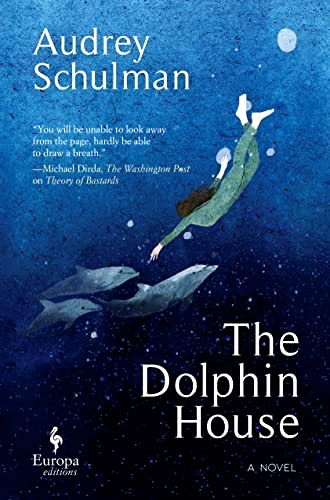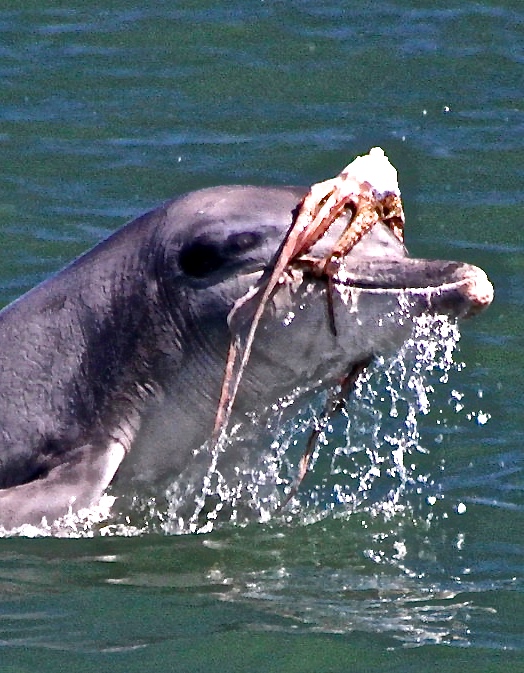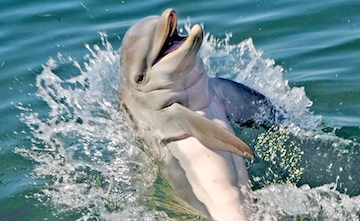“Dolphins are constant vocal innovators, playful geniuses with unspeakable power, the Maria Callas of the sea, their sounds unworldly and pure. A gospel group on helium, hitting all the high notes.”
 In her latest study of an animal species, Audrey Schulman focuses on dolphins, their intelligence, their verbalization, their relationships with humans and each other, and the possibility that they may be able to initiate communication with humans if they and the humans can evolve a common language. Using as a model a scientific experiment conducted by marine scientist John C. Lilly from June to August, 1965, at a St. Thomas research center, the author recreates, and fictionalizes, this experiment in which a scientist lives with a dolphin in a special house for several months. The fictional scientist here, a woman, works directly on a series of experiments to see if the dolphin can be taught human speech, while the male scientists involved in the project are more concerned with recording data and statistics about dolphin/human interaction. Though this project was controversial when it was concluded in the 1960s, real research into the subject of dolphin communication and speech does continue into the present under the direction of Dr. Denise Herzing, whose foundation, The Wild Dolphin Project, funds the ongoing research.
In her latest study of an animal species, Audrey Schulman focuses on dolphins, their intelligence, their verbalization, their relationships with humans and each other, and the possibility that they may be able to initiate communication with humans if they and the humans can evolve a common language. Using as a model a scientific experiment conducted by marine scientist John C. Lilly from June to August, 1965, at a St. Thomas research center, the author recreates, and fictionalizes, this experiment in which a scientist lives with a dolphin in a special house for several months. The fictional scientist here, a woman, works directly on a series of experiments to see if the dolphin can be taught human speech, while the male scientists involved in the project are more concerned with recording data and statistics about dolphin/human interaction. Though this project was controversial when it was concluded in the 1960s, real research into the subject of dolphin communication and speech does continue into the present under the direction of Dr. Denise Herzing, whose foundation, The Wild Dolphin Project, funds the ongoing research.
The story begins with twenty-one-year-old Cora, a young woman, partly deaf, who works in Tampa as a waitress at a club, lip-reading as she works. When an episode with an aggressive customer leads her to escape the club one night and decide not return, she moves to St. Thomas, where she hopes life will be less expensive and more fun. There, Blum, a scientist associated with Harvard, has been working for eight years on animal research, recently deciding to use surgery on the brains of captive dolphins to obtain more information. His experiment on two captive dolphins is a disaster, however, and he is banned forever from Marine World, which has supplied the dolphins. In the process, however, Blum has discovered the intelligence of the dolphins and has decided to apply for his own research grant from NASA, which is actively seeking research topics. Cora meets him at a private beach on St. Thomas, where he is recording dolphin behavior, and she eventually begins to work for him. Since her hearing is dramatically improved whenever she is underwater, she need not wear her special cat’s-eye glasses to improve her hearing, devices which she uses on land but which must not get wet.
Four dolphins become her subjects – Ernie, Kat, Mother, and Junior – each with his/her own personality and set of behaviors. While Cora works with the dolphins separately, always in the water, she observes their behavior, often while tossing pieces of butterfish to them. Blum and her male counterparts stay busy on land, writing notes and collecting data. Cora notices that dolphin Kat particularly enjoys twirling small squid and then hurling them at the faces of other dolphins, and, occasionally, spectators, and she appreciates the fact that Kat is often deliberate about choosing a target. The men do not participate in the on-site observations in the water that Cora does, and they seem not to have inner feelings or empathy for the animals. Blum, for example, has corralled dolphins into shallow water in order to beach them so he can cut incisions into the tops of their heads, the experiment which originally got him into trouble years ago because he used too much anesthesia, and she cannot help but notice that all of the dolphins are affected by these traumatic sessions and change their behavior significantly after they are later released into deeper water. Blum and his assistant have also confined one or more animals to a small tank, then done experiments on them there; denying food to encourage them to do as Blum expects; and setting up tasks which they must perform as he demands in order to be fed. Cora, by contrast, allows the animals to set the tone and speed, adapting her own behavior to stimulate more contact with them and allow them to behave more “normally.”
A crisis comes in the novel when Harvard’s Timothy Leary, a proponent of LSD and other psychedelic drugs, comes for a visit. He regards the dolphins as magical “spirit guides” and decides to approach them directly in the water, marching with purpose to them through the water, though they do not know him. Frightened and upset by his aggressive approach, one of the dolphins aims straight at Leary and makes a rapid move toward him. Leary panics and flees in fear. This episode further highlights the novel’s subtexts involving dominance – between humans and animals and between men and women in the mid-1960s. This all comes to a peak when the group decides to build a “homearium,” a place where one dolphin (Junior) and one researcher (Cora) will live together in a specially devised house in which part is dry, and part is under water. Here Cora works on teaching Junior the alphabet, distinguishing between shapes (square, triangle, circle), recognizing colors and some common children’s songs, learning to say words, and understanding each other and each other’s limits. Soon Cora realizes that as much as she is teaching and training Junior, he is also training her. Eventually, Cora will make a decision that will change the whole research project.
Unfortunately, this “Homearium” section, the final section, becomes increasingly disjointed, with the introduction of a new character, flashforwards to Cora’s life many years later with her own family, and major questions regarding the appropriateness of some of the relationships between researcher and dolphin. The additional effects of Timothy Leary and his “medicines” on some of the head researchers also peripherally affect Cora and her ongoing project with Junior, raising the issue of “who’s in charge here.” Author Audrey Schulman addresses these issues directly in her note at the end of the novel. Here she explains that since the reader might not be as fascinated by what she writes about animals as she is, that “I use every trick I can to keep you invested. My books tend to include a strong plot, charismatic megafauna (polar bears, gorillas, dolphins, etc.), and the threat of violence. Lately I have figured out that adding a touch of sex might help to keep the attention focused.” As a reader/reviewer, I was fascinated by the project involving the dolphins and speech, hopeful that Cora would find some major purpose to her life, and energized by the new knowledge I was receiving. In this final “Homearium” section, however, I felt manipulated by the deliberate addition of extraneous and even irrelevant information, in what the author herself regards as a “trick” attempt to “keep [my] attention focused.”
ALSO by Schulman: THREE WEEKS IN DECEMBER
 Photos. The Cat-s Eye glasses with hearing aids appear on https://www.pinterest.com
Photos. The Cat-s Eye glasses with hearing aids appear on https://www.pinterest.com
A dolphin playing with a squid is found here: https://www.livescience.com
The happy dolphin is one of many shown at this site: https://dolphins.org
The author photo is from https://heet.org
The map of the Virgin Islands shows the location of St. Thomas, home of these experiments. https://www.istockphoto.com




